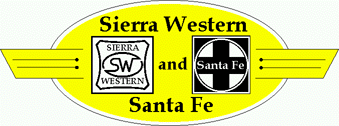
|

|

The Sierra Western and Santa Fe RR evolved from my affection for my previous layout (most of the old layout's main yard will be used on the upper level) and for my favorite railroad, the Santa Fe (how could anyone not love that beautiful Warbonnet paint scheme?). Both are being incorporated into this new layout. The layout room is 28ft x 47ft and was designed and built for this layout. The adjacent 11ft x 22ft 'crew lounge' was added on at the same time. Layout construction began immediately after the room addition passed its final building inspection in July 1994.
The layout is designed for operations and long trains, and follows the 'linear' style of layout design popularized by David Barrow. All track configurations are intended to be as realistic as possible. The mainline will support up to a dozen trains at a time. Up to four switchers can be operated in the Chico yard areas alone. Switching areas have been designed for efficiency, not 'time-saver' type challenges. All passing sidings and main staging tracks will handle trains with three locos and 35 cars. Most benchwork is less than 2 feet deep, and crews will be only a foot away from their train almost everywhere on the layout. Interchange activity will occur at five locations. Additionally, there will be 10 staging locations. There is no hidden track along the mainline between end staging yards, and minimal hidden track at mainline staging areas. Full signalling is planned along with full CTC operations.
Several field trips to Chico, Los Molinos, Anderson, Red Bluff and Redding were made well before the plan was finalized. Using US Geological Survey maps, 3-dimensional topographical maps, AAA road maps, and a variety of books and articles on the railroads of the area, each location being modeled was visited to determine whether our route could conceivably have gone through these areas. Open areas around the towns to be modeled were surveyed to determine the possible location of tracks and yards, focusing on the year that they would have been constructed, and the use of the land at that time. This surveying also considered the requirement for minimum grading and filling, and minimum disturbance to residential areas and streets and highways that existed at that time. Industry types were determined, and scenery, including soil colors, vegetation, fence types, road profiles and pavement colors were noted.
In some instances, the proposed route was adjusted slightly to incorporate actual land profiles and features such as existing hills and cuts to determine the location for overpasses, etc. An example is the layout's Santa Fe bridge over the Southern Pacific at Red Bluff, at a place listed in old SP timetables as 'Glade'. There we found a cut through a hill with the right assortment of surrounding hills that could provide an approach for the Santa Fe's overpass with a minimum of fill work. This was subsequently incorporated into the layout. A study of the Southern Pacific through other portions of this area also provide valuable ideas and information.
At that point, final tweaking was done and the lower level master plan was finalized. This plan has been closely followed, only modifying it by less than 5% so far. The upper level designs have been started and will be finalized when we are closer to building them. Further field trips will be done in the Dunsmir, Redding, Lake Shasta and McCloud areas to provide information about prototypical scenery, features and land profiles to help finalize the remainder of the plan.
Other railroads interchanging with the Santa Fe are: the Sacramento Northern (a part of the Western Pacific in the 70's) - 45ft of visible track and a hidden 4-track staging yard; the Southern Pacific - 110ft of visible track with a hidden 3-track staging yard & reverse loop at each end; the McCloud Railroad - 50ft of visible track and a hidden 4-track staging yard; and the Southern Pacific - the lower section of the helix. Additional interchange will occur 'beyond the layout' with the Union Pacific and the Great Northern.
We are currently writing 'user-friendly' and easy to use Microsoft Windows based programs that will maximize the flexibility of the new DCC technology. With these programs the operators will be able to use the computer keyboard and mouse to reprogram digital loco decoders, change loco lighting effects to simulate strobe lights, rotating beacons, Mars lights, etc., consign locos to consists, assign locos or consists to handheld cabs, and monitor loco runtime hours and maintenance schedules. We'll also generate and print switchlists, train schedules and other railroad documents. Future possibilities being considered include programming the computer to run mainline through-trains while crews perform switching chores in between the passing trains, to randomly power down a locomotive to simulate an engine failure, to automatically adjust the loco response to simulate going up or down a grade, or set off hot-box or dragging equipment detector alarms, etc. Many more 'state-of-the-art' ideas will be incorporated as we progress.
|
|
|
These pages implemented and maintained by: Larry Moseley
Please send all comments to: Rick Fortin